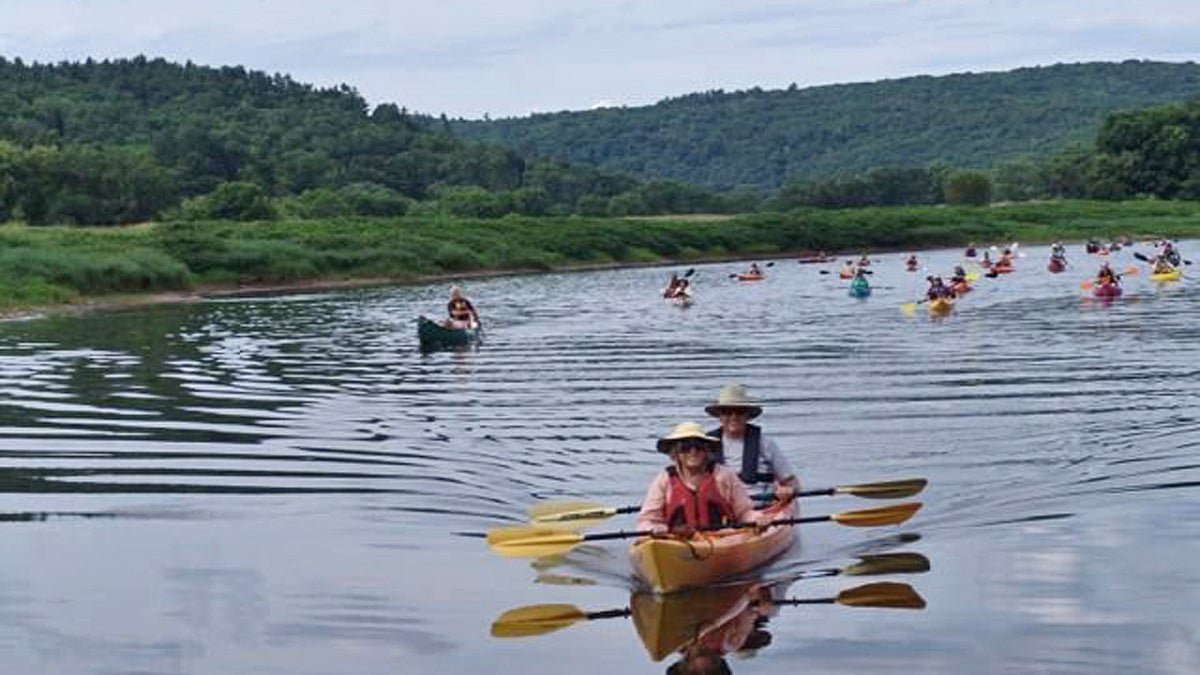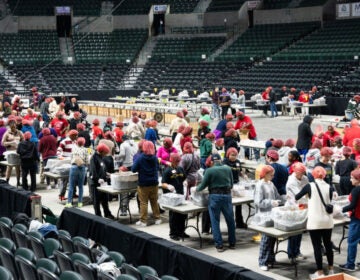Kayak trip raises awareness of Delaware River’s importance to the region

Through the Delaware River Sojourn, paddlers gain new appreciation for the river's ecology and history. (Photo courtesy of Delaware River Sojourn)
This is part of a series from Ilene Dube of The Artful Blogger.
Every river has its stories. For the Delaware, there’s the one about logger Daniel Skinner who, in the 1760s, made an 80-foot raft of logs and set off from the Catskill Mountains to the shore of Philadelphia, some 200 miles downstream. Skinner was honored as Lord High Admiral of the Delaware when he reached Philadelphia. Since 1997, the Delaware River Sojourn has bestowed the title on individuals who have made outstanding contributions to protect the health of the river and its environs.
The goal of the Delaware River Sojourn is to heighten awareness of and appreciation for the ecological, historical, recreational and economic significance of the river, which flows 320 miles through New York, New Jersey, Pennsylvania and Delaware. The Sojourn combines canoeing/kayaking, camping, educational programs and historical interpretation.
Sojourners paddle each section (upper, middle, lower, and estuary), taking detours along historic canals, tidal marshes and scenic tributaries. Area naturalists enlighten Sojourners about the river’s ecology and ties to local communities. The 60-mile trip began June 22 at Ten Mile River Access in New York State, but there are still two more days left to join, from Trenton to Philadelphia, June 28 and 29, putting in at Bull’s Island, New Jersey, .
The daily trips range from six to 10 miles, and are suitable for paddlers at all skill levels. A ride on the Steamboat SPLASH, an authentic steam powered stern wheel paddle boat, will be offered June 28, and a tour of the Independence Seaport Museum and its historic ships, the Olympia & Becuna, on June 29.
During a recent Sojourn, after a safety briefing by the National Canoe Safety Patrol, a volunteer group that paddles alongside the Sojourners, we chanted a blessing and took off. Our group included a grade-school angler in a camouflage fishing hat, a young man about to start at military high school, retired school teachers and B&B owners from the Poconos. There was a gentleman who required crutches on land but paddled mightily in a Klepper, a German folding kayak.
The Delaware is the longest undammed river east of the Mississippi, and supplies water to five percent of the nation’s population — more than 15 million people, we learned. White pine, hemlock, silver maple, elm, sycamore, river birch, oak, sugar maple, beech, black walnut and hickory are among the trees native to the region.
More than 260 species of birds can be spotted along Delaware, which is part of the Atlantic Flyway, including the American merganser, the American Bald Eagle, red tailed hawk, owls, osprey, herons, belted kingfisher, gray catbird, Baltimore Oriole and turkey vultures.
Black bear, white-tailed deer, bobcat, coyote, fox, beaver, otter and aquatic insects and dragonflies are at home here. The upper Delaware is one of the finest fishing rivers in the U.S., with shad, bass, walleye, pickerel, American eel, turtles, frogs, newts, salamanders and snakes.
During the mid 1900s, the Delaware’s shad population was decimated from depleted oxygen in the water. Since the late 1980s, the shad have been making a comeback, thanks to pollution control measures, and their return each spring is celebrated at Lambertville’s Shadfest.
In Trenton, we pulled off onto a small island, where we saw morning glories, nightshade and baby American toads. Sarah Berg of Delaware Canal State Park told us how we’d soon be passing Trenton Falls, where the freshwater river would turn into a tidal zone. It gets very interesting where fresh water mixes with saltwater, and the shad is one of few creatures that survive in both. Shad live in the ocean but travel upstream to spawn in fresh water.
Shad was a wonderful food source for Washington’s troops during the Battle of Trenton, we learned.
After paddling through the Trenton Falls – OK, it’s not Niagara Falls — we could see the RiverLine and the Hamilton-Trenton-Bordentown Marsh.
As we pulled into the Bordentown Yacht Club, some paddlers spotted a peregrine falcon perched under an elevated highway. The wandering bird of prey typically nests on a cliff or, these days, on manmade structures such as this concrete support overlooking the water. It eats small mammals, reptiles, insects and medium-size birds. The peregrine falcon became endangered from rampant use of pesticides, but since DDT was banned it has made a comeback.
“You have to do it for more than one day,” said one of the seasoned Sojourners. “When you spend several days paddling along the river, the shoreline fades away and nature takes over. The river gets into your soul and becomes the new normal.”
Registration fees cover the guided river trip, single or tandem kayak rental (with paddle and PFD), shuttle transportation, educational programs, most meals, a souvenir T-shirt, and optional overnight camping sites. Registration details, daily plans, event guidelines, and more are available at www.delawareriversojourn.org. Register by calling (646) 205-2724 or info@riversojourn.com.
__________________________________________________________
The Artful Blogger is written by Ilene Dube and offers a look inside the art world of the greater Princeton area. Ilene Dube is an award-winning arts writer and editor, as well as an artist, curator and activist for the arts.
WHYY is your source for fact-based, in-depth journalism and information. As a nonprofit organization, we rely on financial support from readers like you. Please give today.




